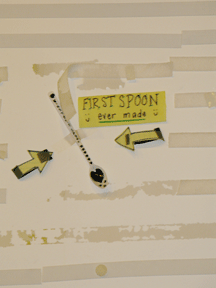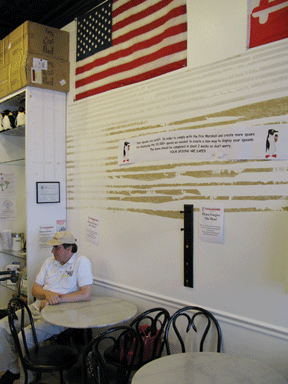
Volume XVII, Issue 31 # July 30 - August 5, 2009 |
 |
Hot Stuff at the Ice Cream Parlor
I scream, you scream, we all scream … Fire ? ! ?
by Diana Beechener
|
|
 |
![]()
What customers saw when they strolled into Annapolis Ice Cream Company on Main Street were bright walls festooned with hand-decorated spoons, the relics of sundaes past. What city Fire Marshal David Shelton saw was a firetrap.
The spoons didn’t start as tinder. After an artistic customer decorated the first spoon, Annapolis Ice Cream Company owner Walter Giera recognized a way to get customers involved in his business. He attached that first spoon to his wall and invited all his customers to decorate their own spoons for the shop.
A bucket of Sharpie markers and a few spare cartons of spoons later, Giera had over 10,000 contributions to his walls of décor. Adding a colored spoon to the Annapolis Ice Cream Company has become a tradition, keeping customers coming in a tough economy.
“The spoons have been there five years,” says Giera. “People love to find their spoons on the wall. Adults have trouble finding their spoon, but kids are great at it.”
Giera’s spoon decorations gained such popularity that they were featured in The Capital.
But the free publicity came with a high cost. Local fire marshals read the article and spotted danger.
“NFPA 701 is for interior wall surfaces,” says Shelton, who brought bad news to Annapolis Ice Cream Company on a surprise inspection. “A building that is non-sprinklered is allowed to have only 10 percent of the walls covered by combustible materials. They had the spoons running from floor to ceiling.”
The spoons had to go.
“We had 30 days [to take down the spoons],” says Giera — though he got a stay for hospital time.
|
|
![]() Ripping down the spoons left raw tracks of damage. Not only the walls but also the spirit of the shop suffered.
Ripping down the spoons left raw tracks of damage. Not only the walls but also the spirit of the shop suffered.
Giera reports customer reaction as “100 percent negative. A lot of customers say What do you mean spoons are flammable?”
Shelton doesn’t like to play the Grinch, but he sometimes must.
“It’s not like we’re looking to give them a hard time,” Shelton says. “God forbid if we didn’t do this and something happened.”
Giera still feels the decree from the fire marshal was an overreaction.
“We tried to burn [the spoons]. They don’t burn. They melt,” he reports.
Shelton knows that melted plastic isn’t innocuous.
“They burn very quickly, very hot. They’re plastic and petroleum-based, so the toxins given off would fill that room very quickly,” Shelton explains. “If there was a fire in that building, because it’s historic and non-sprinklered, it would spread so fast and add to the fire load. People have to get out, and we have to get in.”
Giera’s focus is on the threat of unnecessary expenditures, not fires.
“It’s gonna cost a fortune to refinish the walls,” says Giera, who will repair his shop himself. “For a big company it would be nothing, but for us it’s a lot of money.”
In spite of the expense, Giera is committed to displaying his customers’ artwork. He’s saved the thousands of spoons from the wall, and collects 200 new spoons a week from customers.
“The good news is we have a solution,” Giera says. “We’re going to have as many spoons as we did before, but they’ll be on panels on rails on the walls. You’ll be able to flip them like pages in a book.”
Giera got the fire marshal’s approval before he began to redecorate.
“We had a chance to design a system that would work,” Giera says. Shelton’s “happy, so I’m happy, so we’re all happy.”

